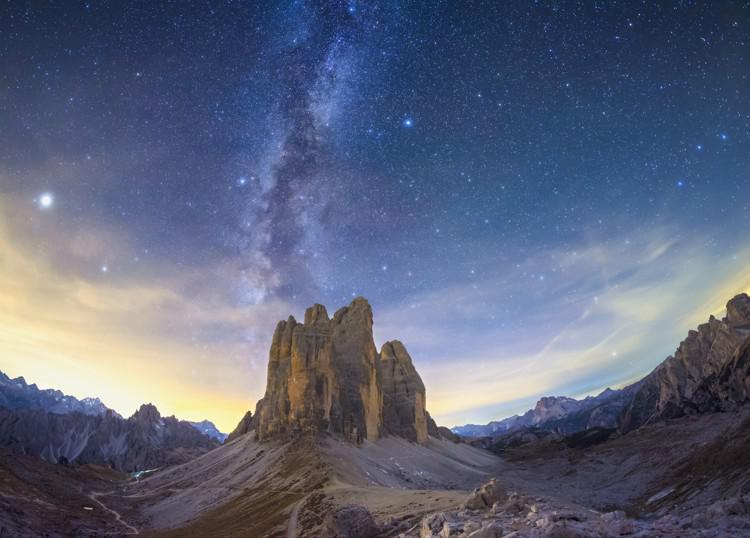This page describes an image The Pillar of Creation
Caption:
Winner in the 2022 IAU OAE Astrophotography Contest, category Still images of celestial patterns.
This image shows the night sky over Tre Cime di Lavaredo, (Dolomites Natural Park), in the region of Veneto, Italy, in October 2021.
The bright spot on the left-hand side is the planet Jupiter, appearing in the constellation Capricorn. To the right of Jupiter and below the two horn stars of Capricorn is the planet Saturn. Just above Jupiter we can see parts of Aquarius, one of the largest constellations and also part of the Zodiac. North of these constellations, left of the Milky Way, there are mostly faint stars. The brighter whitish one in the top left corner is Enif, a binary star in the constellation Pegasus.
The Milky Way seems to emerge from a rock like celestial vapour. Roughly centred in the image are two bright stars left and right of the Milky Way: Altair and Vega, respectively. They seem to be separated by the galactic stream, as told in a popular Chinese folk story where they represent a loving couple. Today, in popular astronomy, the fairly bright star at the upper edge of the photograph is added to form a huge triangle with them, the Summer Triangle in the northern hemisphere.
Altair is the brightest star of the Babylonian constellation Aquila, the Eagle. In ancient Babylon, it was said that the Eagle was carrying king Etana up in the air so that he could see Earth from above. Next to the Babylonian Eagle was the constellation of the Corpse, that returned only in Roman times when Ptolemy put it below the Eagle as the new sub-constellation “Antinous”. It is seen as the corpse (or soul) of the Roman emperor Hadrian’s favourite who had just died in the Nile.
Vega is the bright white star to the right of the Milky Way. It forms part of the small constellation Lyra, famous for hosting the Ring Nebula, which is an impressive planetary nebula — a dying star blowing its gas into space.
At the right edge of the image, three stars in a bent row appear rather prominently. This is the handle of the Big Dipper pointing downwards to a bright star close to the horizon: Arcturus, the bright star of the constellation Bootes (Greek: the Ploughman). This kite-like constellation is probably a pagan interpretation of the Babylonian god “Enlil” whose constellation also occupied that place in the sky. The Romans re-interpreted this figure as The Ox-Driver who controlled the Seven Oxen seen in the bright stars of Ursa Major.
Directly right of Vega, there is the huge constellation Hercules and below it, directly to the left of Bootes, we find a half-circle of stars comprising the small constellation Corona Borealis, associated with Ariadne, daughter of King Minos of Crete in Greek culture.
The lights seen in the bottom left side of the image are due to the reflection of artificial lights in the clouds.
Credit:
Giorgia Hofer/IAU OAE
DOI: 10.5281/zenodo.7425140
Related glossary terms:
Capricornus
, Dust
, Dust Cloud
, Interstellar Extinction
, Jupiter
, Milky Way
, Saturn
Categories:
Milky Way and Interstellar Medium
, Naked Eye Astronomy
License: Creative Commons Attribution 4.0 International (CC BY 4.0) Creative Commons Attribution 4.0 International (CC BY 4.0) icons
The media file captions presented on the OAE website were written, translated and reviewed by a collective effort from the OAE, the OAE Centers and Nodes, the OAE National Astronomy Education Coordinators (NAECs) and other volunteers. You can find a full list of credits for our translation project here. All media file captions are released under a Creative Commons CC BY-4.0 license and should be credited to "IAU OAE". The media files themselves may have different licenses (see above) and should be credited as listed above under "credit".
Captions in Different Languages:
Caption: Auszeichnung beim IAU OAE Astrofoto-Wettbewerb 2022, Kategorie Weitwinkelaufnahmen von Himmelsmustern.
Dieses Bild zeigt den Nachthimmel über den Drei Zinnen (Naturpark Dolomiten) in der Grenzregion zwischen Südtirol und Venetien in Italien im Oktober 2021.
Der helle Fleck auf der linken Seite ist der Planet Jupiter, der im Sternbild Steinbock zu sehen ist. Rechts von Jupiter und unterhalb der beiden Hornsterne des Steinbocks befindet sich der Planet Saturn. Direkt über Jupiter sind Teile des Wassermanns zu sehen, einem der größten Sternbilder und ebenfalls Teil des Tierkreises. Nördlich von diesen Sternbildern, links von der Milchstraße, befinden sich hauptsächlich schwache Sterne. Der hellere weißliche Stern in der oberen linken Ecke ist Enif, ein Doppelstern im Sternbild Pegasus.
Die Milchstraße scheint wie Dampf von den Felsnadeln der Zinnen aufzusteigen. Ungefähr in der Mitte des Bildes befinden sich zwei helle Sterne links und rechts der Milchstraße: Altair und Vega. Sie scheinen durch den galaktischen Strom getrennt zu sein, wie es in einer traditionellen chinesischen Geschichte heißt, in der sie ein liebendes Paar darstellen. Heute ergänzt der helle Stern am oberen Rand des Fotos die beiden in der volkstümlichen Astronomie zu einem großen Dreieck: dem Sommerdreieck auf der Nordhalbkugel.
Altair ist der hellste Stern des babylonischen Sternbilds des Adlers (lat. Aquila). Im alten Babylon hieß es, dass der Adler den König Etana in die Lüfte trug, damit er die Erde von oben sehen konnte. Neben dem babylonischen Adler befand sich das Sternbild der Leiche, das erst in römischer Zeit wieder auftauchte, als Ptolemäus es als neues Untersternbild "Antinoos" unter den Adler stellte. Er wird als der Leichnam (oder die Seele) des Lieblings des römischen Kaisers Hadrian angesehen, der gerade im Nil gestorben war.
Vega ist der helle weiße Stern rechts von der Milchstraße. Er gehört zum kleinen Sternbild Leier, das für den Ringnebel bekannt ist, einen beeindruckenden Planetarischen Nebel - ein sterbender Stern, der seine äußere Hülle in den Weltraum bläst.
Am rechten Rand des Bildes fallen drei Sterne in einer gebogenen Reihe auf. Dies ist die Deichsel des Großen Wagens, der nach unten zu einem hellen Stern in der Nähe des Horizonts zeigt: Arktur, der hellste Stern des Sternbilds Bootes (griechisch: der Pflüger). Dieses drachenähnliche Sternbild ist wahrscheinlich eine heidnische Interpretation des babylonischen Gottes "Enlil", dessen Sternbild ebenfalls an dieser Stelle des Himmels stand. Die Römer deuteten diese Figur als den Ochsentreiber um, der die sieben Ochsen kontrollierte, die in den hellen Sternen der Großen Bärin (lat. Ursa Major) zu sehen sind.
Direkt rechts von Vega befindet sich das riesige Sternbild Herkules, und darunter, direkt links von Bootes, finden wir einen Halbkreis aus Sternen, der das kleine Sternbild Corona Borealis bildet, das in der griechischen Kultur mit Ariadne, der Tochter des Königs Minos von Kreta, in Verbindung gebracht wird.
Die Lichter, die man unten links im Bild sieht, sind auf die Reflexion von künstlichem Licht in den Wolken zurückzuführen.
Credit: Giorgia Hofer/IAU OAE
Related glossary terms: Dust Cloud , Interstellare Extinktion , Jupiter , Milchstraße , Saturn , Staub , Steinbock Caption translation status: Not yet approved by a reviewer
Caption translators: Carolin Liefke
Caption: Vincitore del concorso di astrofotografia IAU OAE 2022, categoria Immagini fisse di schemi celesti.
Questa immagine mostra il cielo notturno sulle Tre Cime di Lavaredo (Parco Naturale delle Dolomiti), in Veneto, Italia, nell'ottobre 2021.
Il punto luminoso a sinistra è il pianeta Giove, che appare nella costellazione del Capricorno. A destra di Giove e sotto le due stelle del Capricorno si vede il pianeta Saturno. Appena sopra Giove vediamo parte dell'Acquario, una delle costellazioni più grandi e anch'essa parte dello Zodiaco. A nord di queste costellazioni, a sinistra della Via Lattea, ci sono soprattutto stelle deboli. Quella biancastra più luminosa in alto a sinistra è Enif, una stella binaria nella costellazione di Pegaso.
La Via Lattea sembra emergere da una roccia come vapore celeste. Circa al centro dell'immagine si trovano due stelle luminose a sinistra e a destra della Via Lattea: Altair e Vega, rispettivamente. Sembrano separate dal flusso galattico, come racconta una storia popolare cinese in cui rappresentano una coppia di innamorati. Oggi, nell'astronomia popolare, insieme alla stella luminosa sul bordo superiore della fotografia formano un enorme triangolo, il Triangolo estivo nell'emisfero settentrionale.
Altair è la stella più luminosa della costellazione babilonese dell'Aquila. Nell'antica Babilonia si diceva che l'Aquila portasse in aria il re Etana, in modo che potesse vedere la Terra dall'alto. Accanto all'Aquila babilonese si trovava la costellazione del Cadavere, che ritornò solo in epoca romana quando Tolomeo la pose al di sotto dell'Aquila come nuova sotto-costellazione "Antinous". È vista come il cadavere (o l'anima) del favorito dell'imperatore romano Adriano, appena morto nel Nilo.
Vega è la luminosa stella bianca a destra della Via Lattea. Fa parte della piccola costellazione della Lira, famosa per ospitare la Nebulosa Anello, un'impressionante nebulosa planetaria - una stella morente che soffia il suo gas nello spazio.
Sul bordo destro dell'immagine, si vedono bene tre stelle in una fila curva. Si tratta del manico dell'Orsa Maggiore che punta verso il basso verso una stella luminosa vicina all'orizzonte: Arturo, la stella luminosa della costellazione di Bootes (in greco: l'aratore). Questa costellazione simile a un aquilone è probabilmente un'interpretazione pagana del dio babilonese "Enlil", la cui costellazione occupava anch'essa quel posto nel cielo. I Romani hanno reinterpretato questa figura come il Conducente dei Buoi che controllava i Sette Buoi visti nelle stelle luminose dell'Orsa Maggiore.
A destra di Vega si trova l'enorme costellazione di Ercole e sotto di essa, a sinistra di Bootes, troviamo un semicerchio di stelle che forma la piccola costellazione della Corona Boreale, associata ad Arianna, figlia del re Minosse di Creta nella cultura greca.
Le luci che si vedono nella parte inferiore sinistra dell'immagine sono dovute al riflesso delle luci artificiali nell
Credit: Giorgia Hofer/IAU OAE
Related glossary terms: Capricorno , Estinzione interstellare , Giove , Nube di polvere , Polvere , Saturno , Via Lattea Caption translation status: Not yet approved by a reviewer
Caption translators: Valentina La Parola









